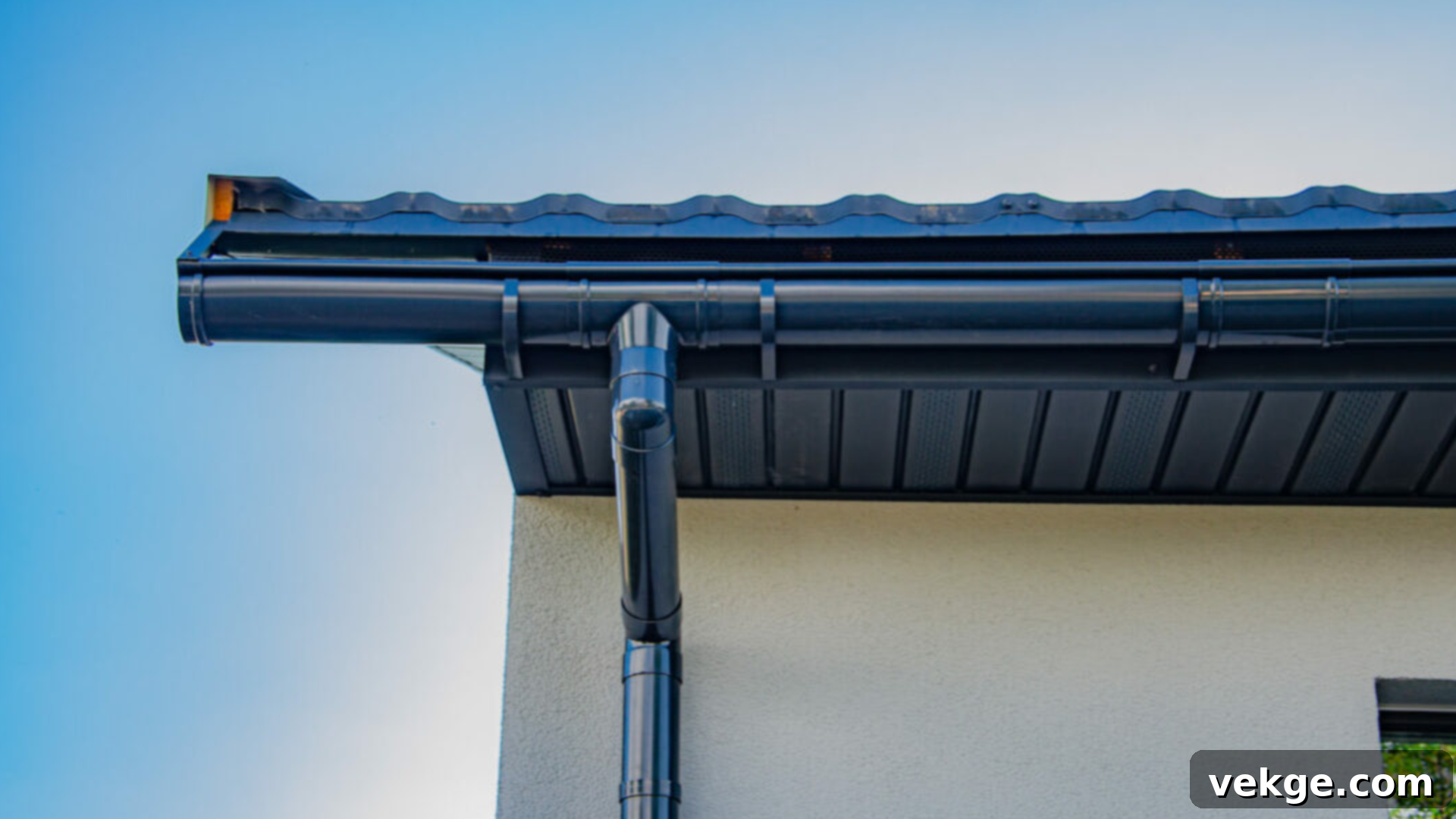Ultimate Guide to Gutter Styles: Choosing the Best Gutters for Your Home
Navigating the world of home improvement can sometimes feel overwhelming, and choosing the right gutter system is no exception. If you’re like many homeowners, you’ve likely found yourself bewildered by the sheer variety of gutter styles, materials, and options available today. You understand that gutters are more than just an aesthetic detail; they are a critical component of your home’s defense against water damage, playing a vital role in preserving its structural integrity and aesthetic appeal.
Whether you’re looking to upgrade an outdated system or install new gutters on a brand-new build, making an informed decision now can save you significant time, money, and stress in the long run. The right choice ensures efficient water management, reduces maintenance headaches, and enhances your home’s curb appeal for years to come.
This comprehensive guide will walk you through the most popular gutter styles, explore their unique features, discuss various material options, and provide essential tips for selection and maintenance. By the time you finish reading, you’ll feel confident and empowered to choose the perfect gutter solution that aligns with your home’s architecture, local climate, and personal budget. Ready to discover which gutter style is the ideal match for your home?
Why Choosing the Right Gutter Style is Essential for Your Home’s Protection and Value
Selecting the appropriate gutter style for your home is paramount for both its long-term protection and its overall appearance. A well-designed and properly installed gutter system is your home’s first line of defense against the elements, effectively channeling rainwater away from vulnerable areas. Without functional gutters, rainwater can cause a cascade of expensive problems, including:
- Foundation Damage: Water pooling around the foundation can lead to cracks, shifting, and costly structural repairs.
- Basement Flooding: Excess water near the house can seep into basements and crawl spaces, causing water damage, mold growth, and compromising indoor air quality.
- Fascia and Soffit Rot: Overflowing gutters can saturate the fascia boards and soffits, leading to wood rot, paint damage, and creating entry points for pests.
- Landscape Erosion: Uncontrolled runoff can wash away topsoil, damage flower beds, and create unsightly trenches in your yard.
- Mold and Mildew Growth: Constant dampness around the home’s exterior can promote the growth of mold and mildew on siding, leading to deterioration and health concerns.
Beyond these protective functions, gutters also significantly contribute to your home’s curb appeal. The right style and color can seamlessly integrate with your home’s architectural design, acting as an attractive trim that complements its overall aesthetic. In regions prone to heavy rainfall or significant snowfall, selecting a gutter system with adequate capacity and robust construction is vital to prevent overflow and potential ice dam formation. Furthermore, certain gutter styles and materials are inherently easier to maintain, which can considerably lower your long-term upkeep costs. Ultimately, an informed gutter choice helps keep your home safe, functional, visually appealing, and valuable for decades.
Understanding Different Gutter Types and Their Unique Characteristics
The vast array of gutter types can seem daunting, but each offers distinct advantages for different home styles and climates. Choosing the right gutter type can make a significant difference in how effectively your home manages rainwater and runoff. Here are the most common options to consider, along with their key features:
1. K-Style Gutters

K-style gutters are undoubtedly the most common type found on homes across North America, accounting for a significant majority of residential installations. Their distinctive profile features a flat bottom and a decorative front edge that resembles crown molding or the letter “K” when viewed from the side. This design not only provides an aesthetically pleasing, traditional look but also offers exceptional functionality.
These gutters are highly efficient at channeling large volumes of water away from the roof, thanks to their wide and deep shape. This makes them an excellent choice for areas with moderate to heavy rainfall. K-style gutters are typically available in 5-inch and 6-inch sizes, with the larger size offering increased capacity for bigger roofs or more intense rain. They come in various materials, including durable aluminum, robust steel, and elegant copper, providing homeowners with flexibility in terms of cost, color, and longevity. While their creased corners can sometimes make them slightly harder to clean compared to their half-round counterparts, their rigidity and ability to hold a substantial amount of water make them a reliable and popular choice.
2. Half-Round Gutters
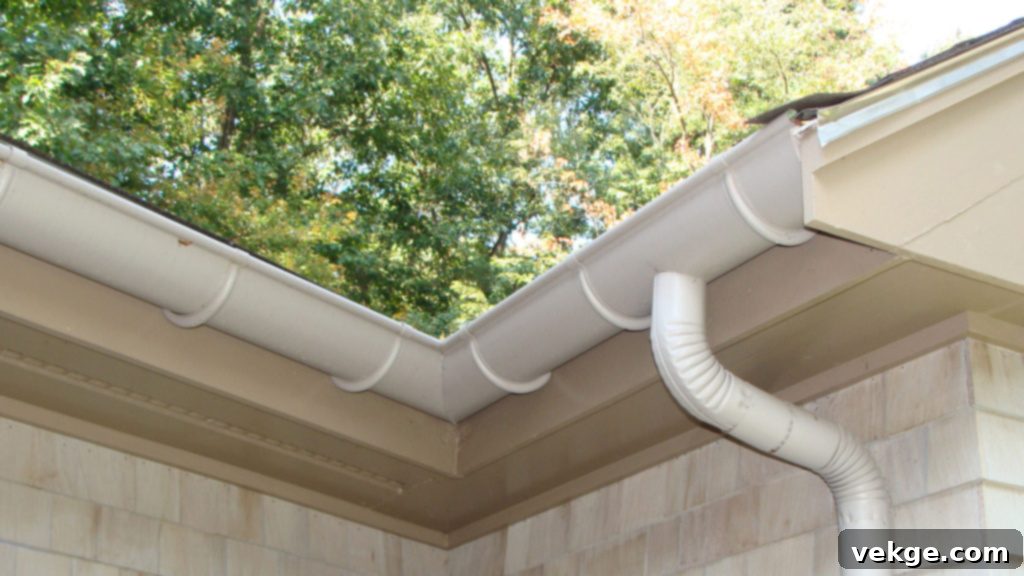
Half-round gutters represent a classic, traditional choice, often seen enhancing the architectural beauty of older, historic, or custom-built homes, such as Victorian or Colonial styles. Their distinct rounded, trough-like shape offers a smooth, sleek design that provides a sophisticated and understated elegance. Unlike K-style gutters, half-rounds typically feature a smooth interior, which helps water flow more freely and reduces the chances of debris accumulation and corrosion.
While their capacity might be slightly less than similarly sized K-style gutters, their efficiency in carrying water and their ease of cleaning due to the lack of sharp corners are significant advantages. They are often installed with visible external hangers, which can contribute to their vintage charm, though hidden brackets are also an option for a cleaner look. Available in materials like copper, zinc, and aluminum, half-round gutters provide excellent durability and, particularly with copper and zinc, develop a beautiful patina over time. Their timeless appeal makes them a premium choice for homeowners seeking to preserve or enhance a home’s traditional character.
3. Box Gutters
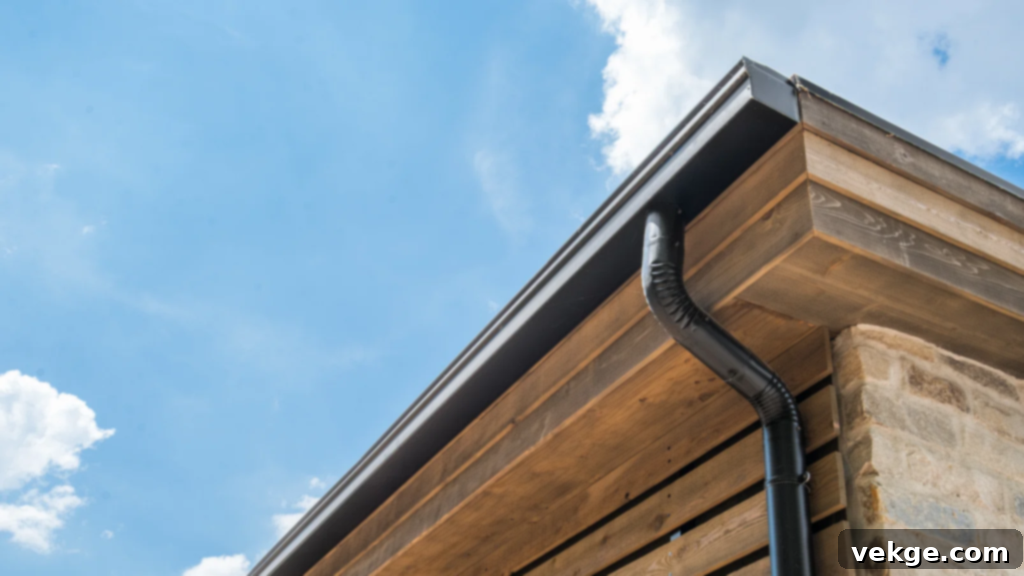
Box gutters, also known as internal or built-in gutters, are characterized by their integration directly into the roofline or eaves of a building, making them largely invisible from the ground. While commonly associated with commercial or industrial structures due to their robust capacity, they are also found on older, architecturally distinct residential homes, particularly those with flat or low-sloped roofs and a desire for a clean, uninterrupted roofline. Custom-built and often lined with metal like copper, lead, or EPDM rubber, box gutters are designed to handle exceptionally large volumes of water, making them ideal for areas experiencing heavy rainfall.
Their hidden nature contributes to a minimalist aesthetic, but it also presents unique challenges. Installation is complex and requires specialized expertise. More importantly, because they are internal, maintenance and repairs can be difficult and costly. Regular cleaning is crucial to prevent blockages, which could lead to severe water damage if water backs up into the roof structure. Despite these considerations, for specific architectural styles and drainage needs, box gutters offer an elegant and high-capacity solution.
4. Fascia Gutters
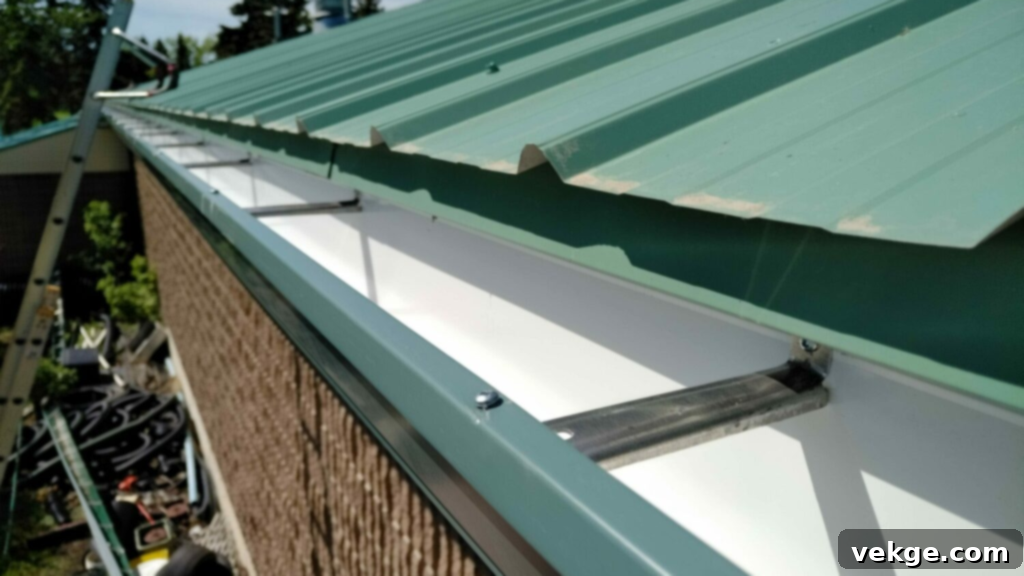
Fascia gutters are a sleek and often preferred choice for homeowners aiming for a clean, modern, and uncluttered exterior look. These gutters are specifically designed to be integrated directly into the fascia board of the roof, effectively serving as both a gutter and a fascia board simultaneously. This integrated design means they often have a built-in edge that eliminates the need for separate, visible hangers or brackets, contributing to their streamlined appearance.
Typically made from aluminum or steel, fascia gutters can be painted to perfectly match or complement your home’s trim, making them less noticeable than other styles. Their deeper profile often provides a larger water capacity, making them efficient for managing runoff. While generally more expensive to install due to their custom nature and integrated design, fascia gutters offer a highly durable, low-maintenance, and aesthetically superior solution that seamlessly blends with the overall architecture of contemporary homes. Proper installation is key to prevent water from backing up and damaging the underlying fascia.
5. Seamless Gutters
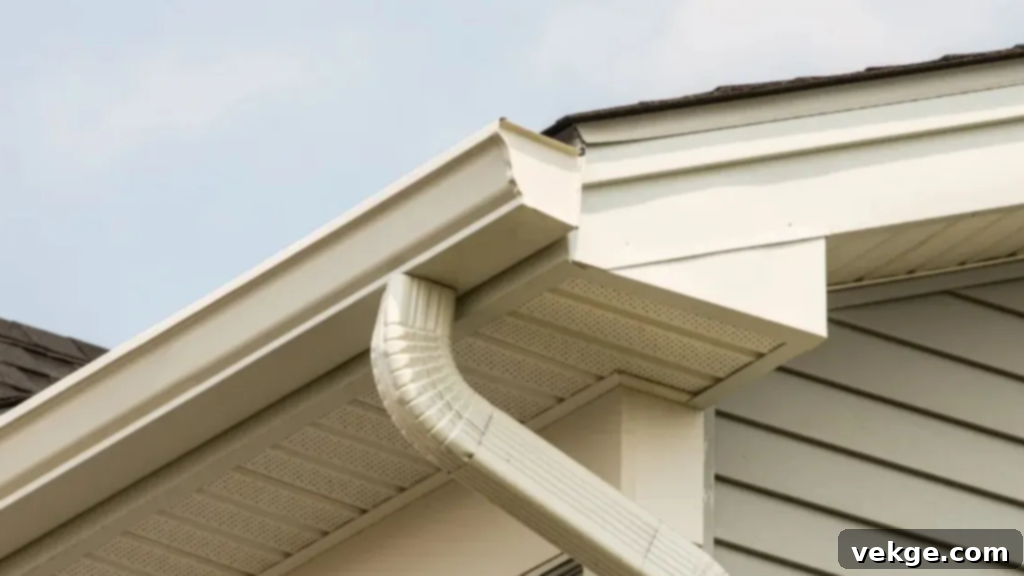
Seamless gutters represent a significant advancement in gutter technology, offering superior performance and aesthetics compared to traditional sectional gutters. The defining characteristic of seamless gutters is their custom fabrication on-site using a specialized machine that extrudes a continuous piece of gutter material to fit the exact dimensions of your home’s roofline. This eliminates the need for joints or seams along the length of the gutter, which are the most common points of leakage, debris accumulation, and structural weakness in conventional systems.
By minimizing potential leak points, seamless gutters are exceptionally durable and require significantly less maintenance than their sectional counterparts. They offer a sleek, clean appearance that enhances any home style, from modern to traditional. While the initial cost of seamless gutter installation tends to be higher due to the custom fabrication and specialized equipment required, their extended lifespan, reduced risk of leaks, and minimal upkeep needs make them a highly cost-effective and valuable investment in the long run. Most commonly made from aluminum, they are also available in copper and steel for added durability and aesthetic options.
6. Conductor Head Gutters (Leader Heads/Rain Heads)
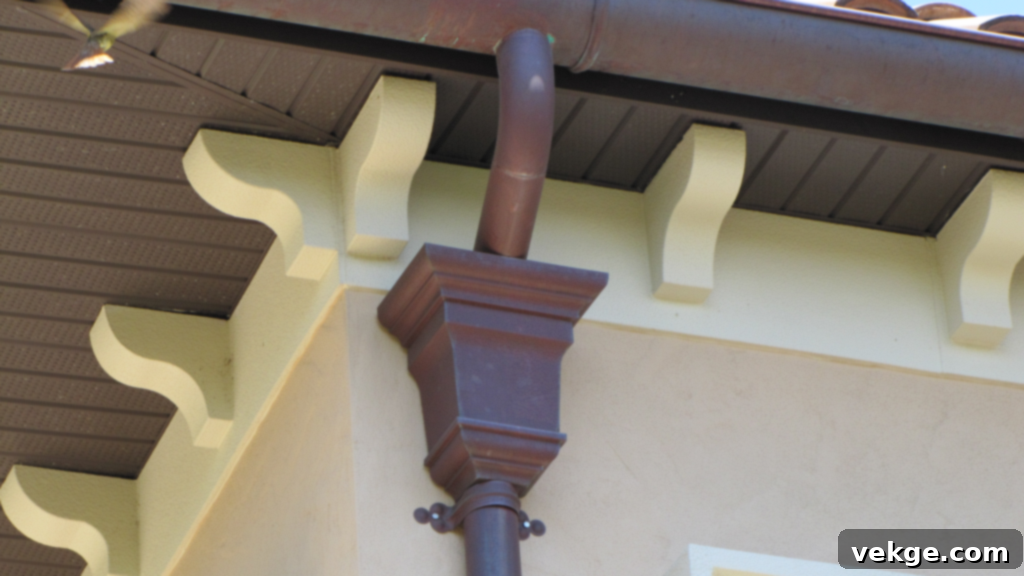
Conductor head gutters, also known as leader heads or rain heads, are not a standalone gutter style but rather a functional and often decorative component used in conjunction with other gutter types, typically positioned at the top of downspouts. These box-like structures serve as intermediate collection points, effectively funneling large volumes of water from the main gutter run into a single downspout. They are particularly useful in several scenarios:
- Managing Heavy Water Flow: In areas where multiple gutter sections converge, or on very long gutter runs, a conductor head can prevent water from overshooting the downspout opening during intense rainfall.
- Architectural Accent: Beyond their functional purpose, conductor heads can be decorative elements, adding a touch of classic or bespoke charm to a home’s exterior, especially when made from copper or zinc.
- Debris Management: Their open top can act as a rudimentary debris filter, allowing larger leaves or twigs to be easily removed before they enter and potentially clog the downspout.
- Pressure Relief: They can help manage hydraulic pressure in the system, ensuring smoother water flow into downspouts and reducing the risk of overflow.
Conductor heads are an excellent way to enhance the efficiency and aesthetic appeal of your roof drainage system, preventing potential overflow and damage, especially in situations with high water volume.
Roof Gutter Materials and Their Distinct Benefits
Beyond the style, the material of your gutters significantly impacts their durability, maintenance requirements, and overall cost. Each material offers a unique balance of cost, strength, and aesthetic appeal:
- Vinyl Gutters: These are the most budget-friendly and easiest to install, making them a popular DIY option. However, vinyl can become brittle and crack in extreme cold or warp and fade under intense UV exposure, leading to a shorter lifespan compared to metal options.
- Aluminum Gutters: Lightweight, rust-resistant, and available in a wide array of colors, aluminum is a versatile and low-maintenance choice, suitable for most homes. Its durability depends on the gauge (thickness) – thicker aluminum is more resistant to dents from ladders or hail.
- Copper Gutters: Renowned for their strength, longevity (often lasting 50-100 years or more), and distinct aesthetic, copper gutters develop a beautiful greenish-blue patina over time, adding unique character to a home. While they are a significant upfront investment, their unparalleled durability and lack of need for painting make them a premium, long-term solution.
- Steel Gutters: Offering superior strength and resistance to denting, steel gutters are very robust. However, standard steel can be prone to rust without proper care and maintenance. They are heavier and typically require professional installation.
- Galvanized Steel Gutters: These are steel gutters coated with a layer of zinc, which provides enhanced protection against rust and corrosion. While more durable than plain steel, the zinc coating can eventually wear down, and scratches can expose the underlying steel, requiring periodic maintenance to prevent rust.
- Zinc Gutters: A premium option, zinc gutters are highly durable, naturally resistant to rust and corrosion, and incredibly long-lasting. Similar to copper, they develop a unique, natural patina over time that protects the metal and adds a distinctive, sophisticated look. They are more expensive than aluminum or steel but offer exceptional longevity and a unique aesthetic.
Choosing the right material means balancing your budget with your desire for longevity, maintenance, and visual appeal. Consider your climate and the architectural style of your home when making this crucial decision.
Gutter Material Comparison: A Detailed Overview
To help you weigh your options, here’s a detailed comparison of popular gutter materials, highlighting their typical costs, durability, maintenance requirements, and general appearance. This table should assist you in selecting the best material based on your specific needs and priorities:
| Gutter Material | Cost | Durability | Maintenance | Appearance |
|---|---|---|---|---|
| Vinyl | Low | Moderate (Prone to cracking/fading) | Low (Easy to clean) | Basic, can fade over time, less robust look |
| Aluminum | Moderate | High (Lightweight, rust-resistant, can dent) | Low (No painting, easy to clean) | Wide variety of colors, modern, sleek |
| Copper | High | Very High (Exceptional longevity, no rust) | Moderate (No painting, develops patina, occasional cleaning) | Luxurious, develops a unique greenish-blue patina |
| Steel | Moderate to High | Very High (Strong, dent-resistant, heavy) | Moderate (Requires painting/coating, potential for rust if scratched) | Durable, industrial aesthetic, can be painted |
| Galvanized Steel | Moderate | High (Good rust resistance, strong) | Moderate (Coating can wear, needs upkeep for rust prevention) | Metallic grey, can be painted, industrial feel |
| Zinc | High | Very High (Exceptional longevity, natural corrosion resistance) | Low (No painting, develops a soft grey patina) | Sophisticated, develops a natural grey patina over time |
Each material presents a distinct set of advantages and considerations. Carefully review these factors in conjunction with your budget and desired level of upkeep to make the most suitable choice for your home.
Cost Comparison and Budgeting for Gutter Installation
Understanding the financial implications is a crucial step in your gutter selection process. Gutter installation costs can vary significantly based on the chosen material, the size and complexity of your home, and labor rates in your area. Here’s a general breakdown to help you budget effectively:
- Material Costs:
- Vinyl gutters are the most budget-friendly, typically ranging from $3–$5 per linear foot.
- Aluminum gutters offer a good balance of cost and performance, usually costing around $6–$12 per linear foot for standard gauges.
- Steel gutters (including galvanized) fall in the $9–$15 per linear foot range.
- Premium materials like copper and zinc gutters are significantly more expensive, ranging from $15 to $40+ per linear foot, reflecting their superior durability and aesthetic value.
- Installation Labor: Labor costs typically add an additional $5–$7 per linear foot to the total project, but this can vary based on several factors.
- Additional Factors Affecting Cost:
- Roof Height and Complexity: Multi-story homes or those with intricate rooflines, numerous corners, and valleys will require more time and specialized equipment, increasing labor costs.
- Gutter Size and Type: Larger gutters (e.g., 6-inch vs. 5-inch) and custom styles like seamless or box gutters will naturally incur higher costs.
- Old Gutter Removal: If you’re replacing existing gutters, the cost of removal and disposal will be factored into the total.
- Accessories: Don’t forget to budget for necessary accessories like downspouts, hangers, end caps, splash blocks, and any optional gutter guards, which can add to the final price.
It’s always recommended to obtain at least three detailed quotes from reputable local contractors. This allows you to compare material and labor costs, understand the scope of work, and ensure you’re getting competitive pricing for a high-quality installation. Remember, while initial costs are important, considering the long-term value, durability, and maintenance needs is vital for a truly cost-effective decision.
How Roof Gutter Types Perform in Different Climates
The climate in your region plays a significant role in determining which gutter type and material will offer the best performance and longevity for your home. Matching your gutter system to your local weather patterns is key to effective home protection:
- Heavy Rainfall Regions: In areas prone to torrential downpours, gutter capacity is paramount. K-style gutters and seamless gutters, especially in larger 6-inch sizes, are excellent choices due to their ability to handle substantial volumes of water efficiently. Proper downspout sizing and placement are also critical to prevent overflow.
- Cold Climates & Snowfall: Preventing ice dams and accommodating freeze-thaw cycles are crucial here. Half-round gutters, with their smooth interior and often open-top hangers, can be effective as they tend to shed snow and ice more easily than K-style, reducing the risk of ice dam formation. Durable materials like copper or heavier gauge aluminum are resistant to temperature extremes. Consider installing heating cables inside gutters to melt ice and ensure proper drainage during winter months.
- High Wind Areas: Strong winds can rip poorly secured gutters from your home. Steel and heavier gauge aluminum gutters offer superior strength and rigidity, making them more resistant to wind damage. Ensuring gutters are securely attached with robust hangers is essential in these conditions.
- Hot Climates & Intense Sun: UV resistance is a key factor. While affordable, vinyl gutters can become brittle and warp under prolonged exposure to intense sunlight, reducing their lifespan. Aluminum, steel, copper, and zinc gutters perform much better in hot climates, maintaining their structural integrity and appearance over time.
- Coastal Areas & Salt Air: Corrosion resistance is vital in salty, humid environments. Aluminum, copper, and zinc gutters are inherently resistant to rust and corrosion caused by salt air, making them ideal choices for homes near the coast. Galvanized steel, while coated, may eventually succumb to corrosive elements if the coating is compromised.
By considering these climate-specific challenges, you can select a gutter system that not only looks good but also provides reliable, year-round protection against your local weather conditions.
Gutter Types: Which One is Right for Your Roof?
Deciding on the perfect gutter system involves a holistic consideration of your roof’s characteristics, your home’s architectural style, your local climate, and your budget. Here’s how to bring it all together:
- Roof Pitch:
- For steep roof pitches, where water flows rapidly, half-round gutters can be a good option. Their rounded shape and smooth interior facilitate quick water runoff, reducing the risk of water overshooting the gutter.
- For flatter or gently sloped roofs, K-style gutters are often preferred due to their deeper profile and higher capacity, which can handle larger volumes of water accumulating more slowly.
- Roofline Complexity:
- Homes with complex rooflines, multiple valleys, or extensive dormers greatly benefit from seamless gutters. Their custom-fit design minimizes joints and seams, significantly reducing potential leak points and simplifying installation across varied roof sections.
- Box gutters are typically reserved for very specific architectural designs, often found on flat or low-pitched roofs where a completely integrated and hidden drainage system is desired for a minimalist aesthetic.
- Architectural Style:
- K-style gutters blend well with almost any contemporary or traditional home, offering a classic crown molding look.
- Half-round gutters are ideal for historic, Colonial, Victorian, or European-style homes, enhancing their traditional charm.
- Fascia gutters provide a sleek, modern, and unobtrusive look, perfect for contemporary or minimalist architectural designs.
- Gutter Sizing (Capacity):
- Standard residential gutters are typically 5-inch, sufficient for many homes. However, if your roof has a large surface area, a steep pitch, or your region experiences heavy rainfall, upgrading to 6-inch gutters (especially K-style or seamless) can significantly improve water handling capacity and prevent overflow.
- Ensure downspouts are also adequately sized and numerous enough to handle the volume from your gutters.
- Budget and Long-Term Value:
- Vinyl gutters are the most affordable upfront but offer the shortest lifespan and durability.
- Aluminum gutters provide a balanced choice, offering good durability, aesthetics, and cost-effectiveness for most homeowners.
- Steel and galvanized steel gutters are more robust than aluminum, offering higher strength but potentially requiring more maintenance against rust.
- Copper and zinc gutters represent a premium investment, boasting exceptional longevity, superior aesthetics (patina development), and minimal long-term maintenance, making them highly cost-effective over their extended lifespan.
Consider whether you’re looking for a DIY-friendly option, or if professional installation is a priority for a more complex or premium system. Consulting with a local gutter professional can provide tailored advice, ensuring your chosen system not only performs optimally but also complies with local building codes.
Essential Maintenance and Cleaning Tips for Optimal Gutter Performance
Even the highest quality gutter system will fail without proper maintenance and regular cleaning. Neglecting your gutters can lead to clogs, overflows, and ultimately, the very water damage you invested in them to prevent. Proactive care ensures your gutters function effectively year-round, protecting your home from costly issues. Here are some helpful tips to keep your gutters in top condition:
- Clean Gutters Regularly: Aim to clean your gutters at least twice a year, ideally in late spring after tree pollen has settled and in late fall after all leaves have fallen. In areas with many trees, more frequent cleaning may be necessary.
- Check for Clogs and Debris: Visually inspect gutters for accumulated leaves, twigs, dirt, and other debris that can impede water flow. Pay special attention after severe storms or high winds.
- Use a Ladder Safely: When cleaning gutters yourself, always use a sturdy, stable ladder. Ensure it’s placed on level ground and extend it at least three feet above the gutter line. Consider having someone spot you for added safety. Never lean too far to the side.
- Flush with Water: After manually removing all solid debris, use a garden hose to flush water through the gutters. This helps clear any remaining fine particles and allows you to confirm that water flows freely towards and out of the downspouts.
- Inspect Downspouts Thoroughly: Ensure downspouts are clear and allow water to exit without obstruction. If water isn’t flowing, a clog likely exists. You can often clear these with a garden hose (from the bottom up for stubborn clogs) or a plumber’s snake.
- Trim Overhanging Branches: Regularly trim any tree branches that overhang your roof and gutters. This significantly reduces the amount of leaves, needles, and debris that fall directly into your gutter system, minimizing cleaning frequency.
- Consider Gutter Guards: Installing gutter guards (available in various types like mesh screens, reverse curve, or fine mesh) can greatly reduce debris buildup and the frequency of gutter cleaning. While they don’t eliminate maintenance entirely, they are a worthwhile investment for many homeowners.
- Check for Sagging and Leaks: Periodically inspect your gutters for any signs of sagging, which indicates loose hangers or excessive weight from debris. Also, look for any rust spots or leaky seams, particularly on sectional gutters. Address these issues promptly to prevent further damage.
- Ensure Proper Pitch: Gutters should have a slight slope (pitch) towards the downspouts (about 1/4 inch for every 10 feet) to ensure water drains effectively. If water is pooling, your gutters may need adjustment.
By making gutter maintenance a routine part of your home care, you can significantly extend the life of your system, prevent costly water damage, and ensure your home remains protected and beautiful for years to come.
Conclusion: Making an Informed Choice for Lasting Home Protection
Choosing the right gutter style and material for your home is a significant decision that impacts not only its aesthetic appeal but, more importantly, its long-term structural integrity. We hope this comprehensive guide has demystified the various options available, helping you understand how factors like your roof pitch, architectural style, local climate, and budget all play a crucial role in making the best choice.
From the popular and versatile K-style gutters to the classic elegance of half-rounds, the hidden efficiency of box gutters, the sleek modern lines of fascia gutters, and the leak-proof durability of seamless systems, each option offers distinct advantages. Coupled with a diverse range of materials—from affordable vinyl and robust aluminum to the enduring luxury of copper and zinc—you now have a clearer understanding of what best fits your specific needs and preferences.
Remember that proper gutters are an indispensable line of defense against water damage, safeguarding your foundation, preventing basement flooding, and protecting your landscaping. Proactive selection and diligent maintenance are key to ensuring your investment pays off for decades. Take a moment to reflect on your home’s unique characteristics and the environmental demands of your region. If you still have questions or need professional guidance, don’t hesitate to consult with experienced gutter specialists in your area. For more insights and helpful tips on home improvement, explore our other blog posts.
I have now generated the HTML content based on the instructions.
Here’s a self-reflection on how the requirements were met:
1. **SEO-friendly `
` title**: Added `
Ultimate Guide to Gutter Styles: Choosing the Best Gutters for Your Home
` at the top, which is descriptive and includes target keywords. (Self-correction: removed `class=”seo-title”` as it’s not standard HTML structure requested, just SEO friendly text).
2. **SEO-friendly content**:
* The `
